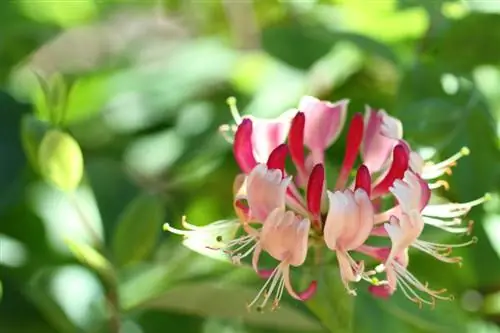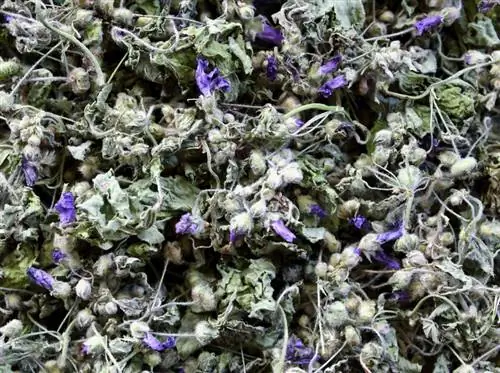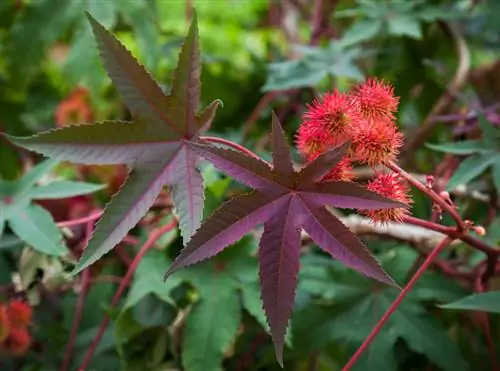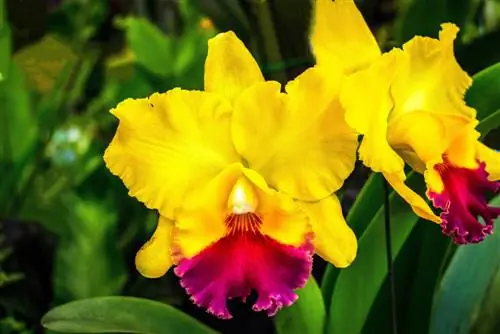- Author admin [email protected].
- Public 2023-12-25 17:45.
- Last modified 2025-01-23 11:21.
The term gloxinia refers to varieties from two genera. This German common name is used for both the garden gloxinia and the non-hardy indoor gloxinia. Both genera differ from the plant genus Gloxinia, which completes the confusion.
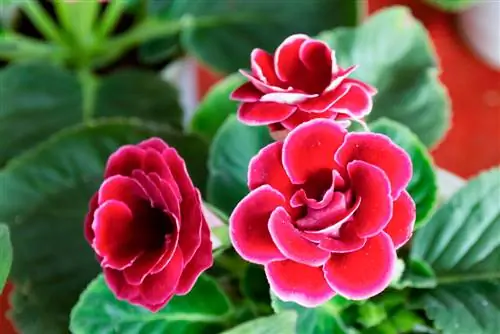
What are gloxinias and how do you care for them?
Gloxinias are ornamental plants from the genus Sinningia that are valued for their magnificent, funnel-shaped flowers. They can be grown as houseplants or outdoors, like partially shaded locations and require moderate watering. The plants are perennial and can be propagated by sowing, division or cuttings.
Origin
Gloxinias from the trade are cultivated forms of the species Sinningia speciosa and other representatives within the genus Sinningia. Common species used for breeding are Sinningia villosa or Sinningia helleri. The genus contains between 60 and 80 species and belongs to the Gesneria family. The species come from tropical climates of South and Central America. Sinningia speciosa grows in the rainforests of Brazil.
Sinningia speciosa was originally assigned to the genus Gloxinia. The family relationships have now changed, but the German common name has not changed.
Attention, risk of confusion:
- Garden gloxinias belong to the genus Incarvillea
- Species belong to the trumpet tree family
- grow at high altitudes in Central and East Asia
Growth
Gloxinias of the genus Sinningia grow as herbaceous plants whose shoots arise from an underground tuber. This rhizome is used for survival. As slow-growing plants, gloxinias reach heights of between 15 and 30 centimeters. They develop a bushy, compact shape and grow between 30 and 60 centimeters wide. Gloxinias are perennial.
leaves
Sinningia hybrids develop ovate to oblong leaves that are green in color and covered by velvety hairs. The edge of the leaf is notched. Each leaf vein ends in a tooth at the edge. The deciduous plants have simple, stalked leaves that can be up to six centimeters long. While the underside of the leaf blade appears light, the upper side of the leaf is slightly darker in color. Sinningia speciosa has leaves arranged oppositely on the stem. Many cultivated forms develop a basal rosette of leaves.
The newer hybrids have bred leaves that are very soft and small. The first cultivated forms had large and tough leaves that were easily destroyed during transport.
Bloom
The flower stalks grow above the leaves. Sinningia varieties bear strikingly large flowers whose petals are shaped into a funnel. The crown grows between two and six centimeters long. It is surrounded by a five-lobed calyx whose leaves are bell-shaped. The individual segments are triangular to lanceolate in shape. In some cultivated forms the flowers are double, so that they are reminiscent of the shape of old roses.
Sinningia species develop their flowers between June and August. The color palette is very rich. While Sinningia speciose develops salmon-red flowers, the cultivars shine in white, red or blue-violet. There are varieties whose petals appear multicolored. Its flowers can be white-edged, white-pink speckled, or ruffled. Some gloxinias develop tubular flowers, while some varieties are reminiscent of African violets. There are now varieties that look more original and are more reminiscent of the wild species Sinningia speciosa. They have smaller flowers that hang slightly.
Usage
Sinningia hybrids serve as flowering and fruit ornamental plants. They decorate interiors and are used for colorful arrangements of potted plants. Because gloxinias can be grown from seeds all year round, they are popular plants for the winter garden. Due to its location requirements, this plant is perfect for beautifying showcases. Garden gloxinias are more robust than their container-planted namesakes. They can be cultivated outdoors. Here the plants provide colorful accents in the partially shaded rock garden.
Is gloxinia poisonous?
Gloxinias do not contain any toxic substances and can therefore safely decorate rooms where pets live. There is also no risk of poisoning in humans after accidentally consuming the flowers or leaves.read more
Which location is suitable?
Sinningia varieties prefer a warm and bright location where there is high humidity. Make sure the place is not in direct sunlight. Gloxinias like a partially shaded location in heated rooms or warm houses. They cannot tolerate drafts and react sensitively to temperature fluctuations.
How to plant garden gloxinias in the bed:
- at a distance of 20 to 30 centimeters
- to a depth of five centimeters
- with 13 plants per square meter
read more
What soil does the plant need?
Commercial potting soil is suitable as a substrate for Sinningia-Hybrige. Mix this with sand to increase permeability. Alternatively, you can use cactus soil that already has well-draining properties. The substrate should be moderately moist, but no waterlogging should occur. The delicate root tuber rots easily if the soil is too wet. This weakens the plant and allows mold spores to settle.
Garden gloxinias grow in neutral to slightly acidic soil with a pH value between five and seven. There are some varieties that are suitable for calcareous substrates.
Propagate Gloxinia
Gloxinias can be propagated with a lot of patience and proper care. Both sowing and growing leaf cuttings are possible. The flowering beauties can also be propagated by division. To do this, the plants and their tubers are dug up and the substrate is removed.
Larger tubers are cut with a sharp knife. Allow the pieces to air dry and place them in a sandy substrate. Keep the soil moderately moist. At temperatures of 20 degrees Celsius, the rhizome pieces soon form fresh roots.
Good to know:
- Dividing potted plants in spring
- Divide garden gloxinias before overwintering in autumn
- Dust interfaces with carbon powder
read more
Sowing
The collected gloxinia seeds can be sown between October and February. The tiny seeds are scattered on growing or cactus soil. Press the seeds lightly and make sure that they are not covered by the substrate. Sinningia gloxinias germinate in light. The substrate is slightly moistened. A spray bottle is recommended so that the soil is not washed away. Cover the planter with a transparent film or a glass hood. Place the pot in a bright location with temperatures of 25 degrees Celsius. Remember to provide regular ventilation to prevent the plants from getting moldy.
As soon as the seedlings show their first leaves, the young plants can be pricked out and placed in a larger container. The plants can be further cultivated at 15 degrees Celsius. It takes up to three years for the plants to bloom for the first time.
Cuttings
Cut leaves from a he althy mother plant during the growing season and place them in a planter filled with nutrient-poor potting soil. Moisten the substrate and place a glass over the leaf cuttings so that the humidity remains constant and the substrate dries out less quickly.
Place the pot in a warm and bright location. Temperatures around 25 degrees Celsius are ideal. Air the jar twice a day and rinse it with warm water. This measure prevents mold formation. It takes up to six months for the cuttings to develop roots and produce new leaves.
Advance
This measure is possible for the commercially available tubers of garden gloxinias. They can be planted directly in a bed from the end of May or brought forward from March. Pre-grown specimens begin to germinate and flower earlier.
Use a sufficiently large bucket with a diameter between 20 and 30 centimeters. This is filled with potting soil or normal garden soil. The tubers are inserted vertically into the substrate and covered loosely. Place the pot in a warm place where the thermometer is between 18 and 22 degrees. Keep the soil moderately moist.
The early plants can be planted outside from mid-May. Loosen the soil well and mix some sand into the soil to increase permeability. To support growth, you can spread some compost. Place the root heart at least five centimeters deep into the soil and be careful not to damage any roots.
Gloxinia in a pot
Gloxinias of the genus Sinningia are cultivated exclusively as pot plants. In pots, the plants beautify interior spaces and winter gardens. Make sure the pot has a drain hole. Optimal water drainage is important to prevent mold from forming. Cover the bottom of the pot with expanded clay, pebbles or shards of pottery. The material ensures that the substrate does not trickle out of the hole. Excess irrigation water can drain away optimally. A clay pot also ensures that the water balance is regulated because the moisture can escape through the porous material.
Balcony
If the conditions are right, Sinningia varieties can easily be cultivated on the balcony. They thrive optimally in a partially shaded location on a south-facing house wall. The flowers develop best here when there is no draft. Protect the plant from rain as the leaves quickly become unsightly.
Watering gloxinia
Sinningia varieties have moderate water requirements. Potted plants are watered regularly. Allow the soil to dry between watering sessions. Garden gloxinias enjoy watering during longer dry periods. A layer of mulch improves the water balance in the soil. It ensures that the substrate dries out more slowly. Pour the water directly onto the root ball to prevent the leaves from getting wet.
Cut gloxinia correctly
A regular section of spent stems stimulates the formation of more flowers. In this way, both houseplants and outdoor perennials develop into permanent bloomers. If leaves have wilted, they can be removed regularly. Cut the stems close to the ground.
In autumn the plants retreat. They store their energy in the rhizomes, so that the above-ground shoots and leaves wither. As soon as the plant parts are completely dead, you can cut them back to five centimeters above the ground.
Fertilize gloxinia properly
The perennials in the bed cover their nutrient needs all year round with the help of compost in the spring. If you cannot give the plants compost, a slow-release fertilizer such as horn shavings or blue grain is suitable. Potted plants should be fertilized every two to three weeks. Give the plants a liquid fertilizer mixed with the irrigation water. Fertilization is not necessary if the plants have been recently repotted.
How do I transplant correctly?
Garden gloxinias can be transplanted in spring. This measure makes it possible to divide the tubers in order to multiply the garden beauties. Potted plants can also be transplanted after overwintering before the tubers sprout again.
hardy
While garden gloxinias are hardy, indoor gloxinias have problems with cool temperatures. Their wintering differs in terms of care.
Garden Gloxinias
They can tolerate temperatures down to -20 degrees Celsius. While the tubers have no problems with frosty temperatures, they can be damaged by moisture in the substrate. It therefore makes sense to dig up the tubers from the bed and place them in a cardboard box lined with straw. The tubers are overwintered in a cool and dry place and grown again in spring. This overwintering is also possible for tubers of the Sinningia varieties.
Plant pots with garden gloxinia tubers overwinter in a frost-free location on an insulating surface. Protect the pot with a jute bag, foil or garden fleece to prevent the substrate from freezing completely. The substrate is watered on frost-free days.
Room gloxinias
Sinningia varieties can continue to be cultivated over the winter. Overwintering without a rest period requires extensive care. Place the plant in an unheated room with temperatures between ten and 15 degrees Celsius.
The perennials need a lot of light. Their ability to grow is improved if they receive artificial light for several hours a day. The plants do not need any fertilizer. Your water needs are minimal during this time. The tubers must not dry out as they will not survive.read more
Pests
Gloxinias that are cultivated as houseplants suffer from infestation by aphids, thrips or spider mites if conditions are too dry. They feed on the plant sap, causing the leaves to curl up and die.
Snails are feared pests that attack young garden gloxinia plants in spring. They eat fresh shoots and leaves of outdoor perennials. Loosen the soil around the plant regularly. This causes the substrate to dry out on the surface so that the snails can't get to the plants as easily.
Fungal infestation
Waterlogging is a typical care mistake that leads to rotting of the roots. Fungal spores find optimal growth conditions. They settle in the putrid areas and develop a fungal mycelium that penetrates the plant organism. It is further weakened by the fungal attack. The leaves turn yellow and slowly die.
Tip
Since the velvety, hairy leaves of all gloxinias do not tolerate water, you should increase the humidity in other ways. Place the planter in a planter filled with pebbles and fill it with a little water. The moisture evaporates slowly and ensures an optimal moisture content in the air.
Varieties
- Scarlet: Sinningia hybrid with intense red flowers.
- Kaiser Friedrich: Sinningia variety with red petals, edged with white.
- Tigrina: Sinningia cultivar with speckled flowers.
- Alba: Incarvillea variety with white petals.
- Deli Rose: Incarvillea breed with magenta-colored flowers.


